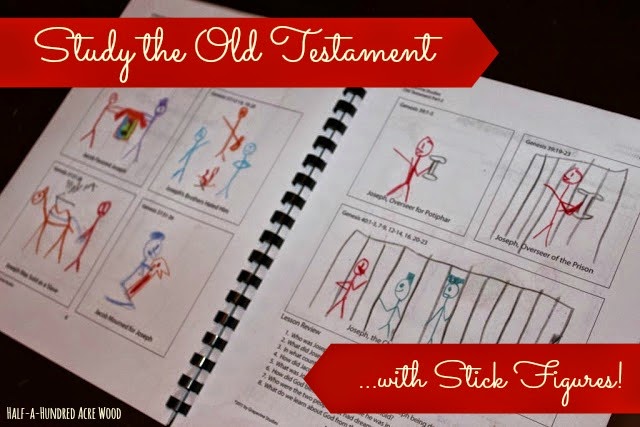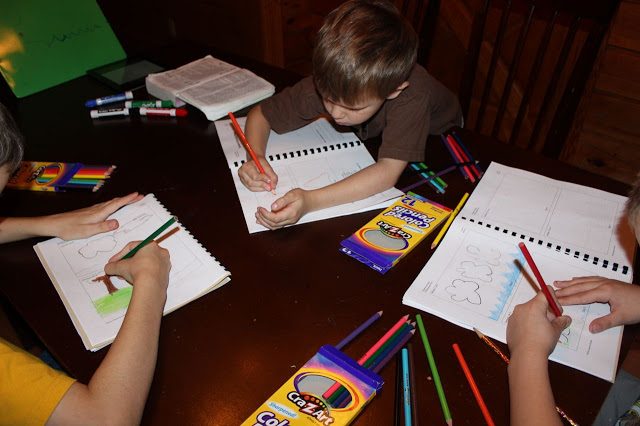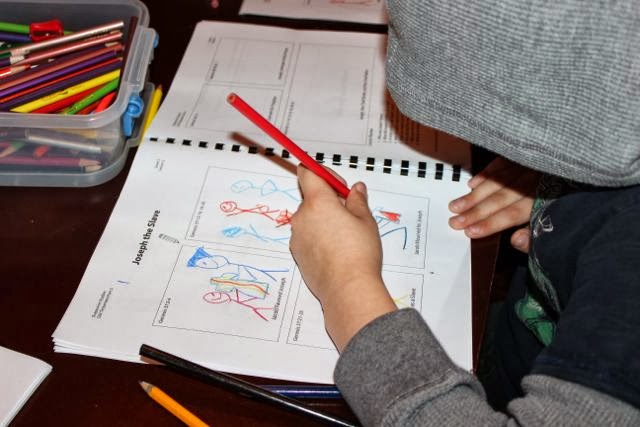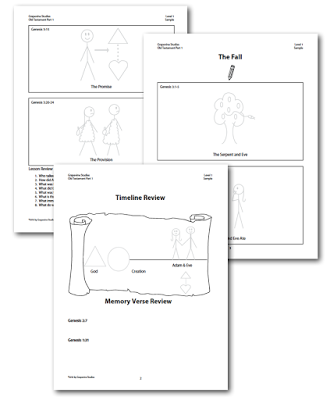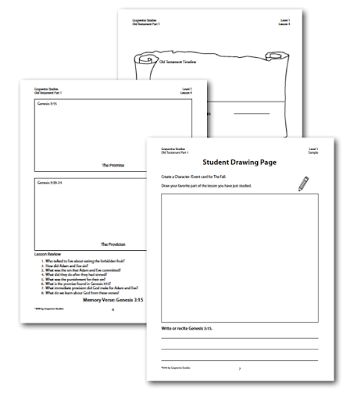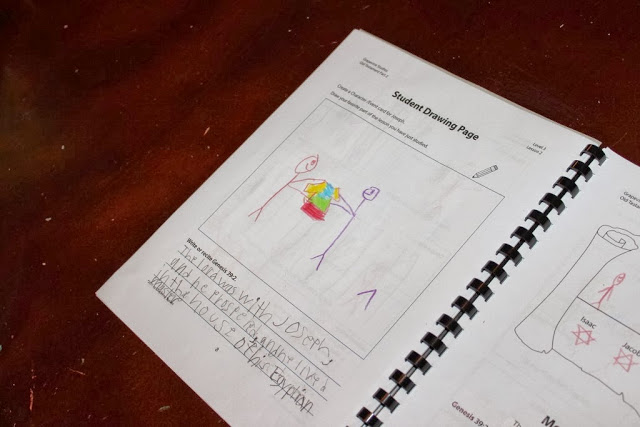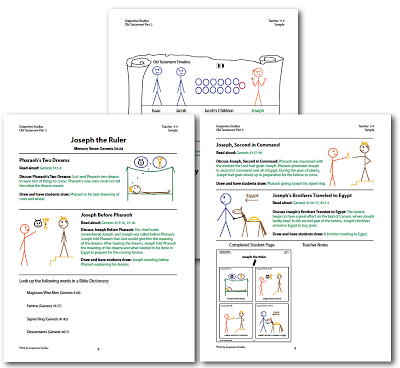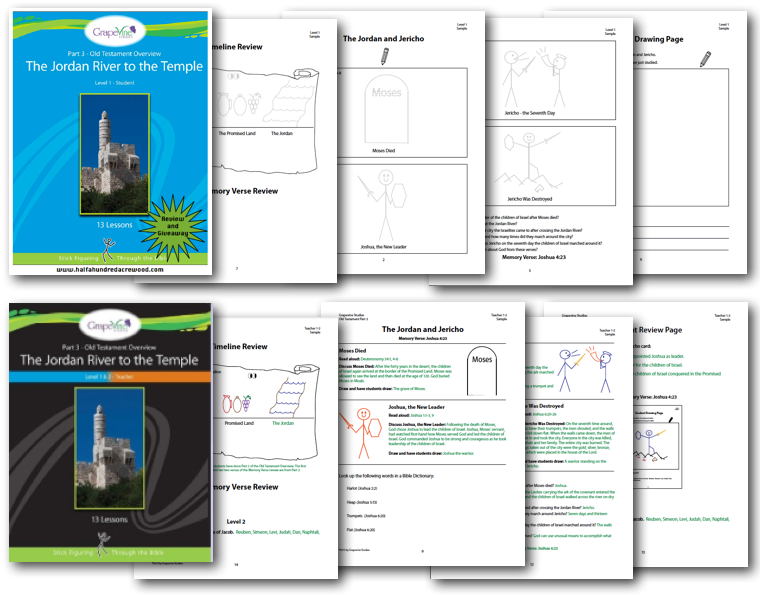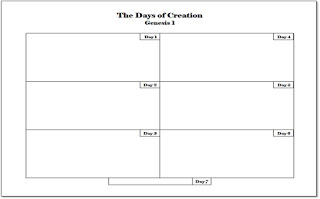When Levi discovered I had printed and bound his Old Testament Bible Study, he grabbed it and shouted, “It’s my Bible study! I love it! I love it! I love it!” He had been asking all summer about when we were going to draw Jesus again. That night, he fell asleep while clutching his new Bible study in his hands.
This year we’re stick-figuring our way through the Old Testament with the Old Testament Overview Study from Grapevine Studies. Written for ages 3 through adult, the four parts of Old Testament Overview provide a chronological study of the Bible that helps to solidify our understanding of each major section of the Old Testament. The Old Testament Overview is split up into four parts:
- Creation to Jacob (Part 1)
- Joseph to the Promised Land (Part 2), which not only includes details about the Ten Commandments, it also includes lessons on the Tabernacle and the Promised Land (the Canaanites and resulting conflicts), which have been overlooked in Sunday School and our other Bible lessons
- The Jordan River to the Temple (Part 3), which includes lessons on the Judges, Ruth, Samuel, King Saul, David the Warrior, David the King, King Solomon, The First Temple, and Psalms and Proverbs
- The Prophets (and Kings of Israel) through Nehemiah (Part 4), which includes lessons on The Prophets, The Kings of Israel, The Divided Kingdom: Israel, The Kings of Judah, The Divided Kingdom: Judah, Daniel and His Friends, Daniel and His Enemies, The Second Temple, Esther, and Ezra and Nehemiah
Each of the Grapevine Studies Old Testament studies start with a Timeline Overview, followed by 10 lessons that dive deeper into the main events recorded in that portion of the scripture, followed by a Final Review that wraps up the study. This gives a total of 12 weekly lessons or 45 daily lessons. [Our family finished the four parts of the Old Testament Overview in a single year, but these studies can also be completed across a two-year period.]
The first lesson, the timeline overview, guides the student through the big-picture of what will be studied using stick-figure drawings.
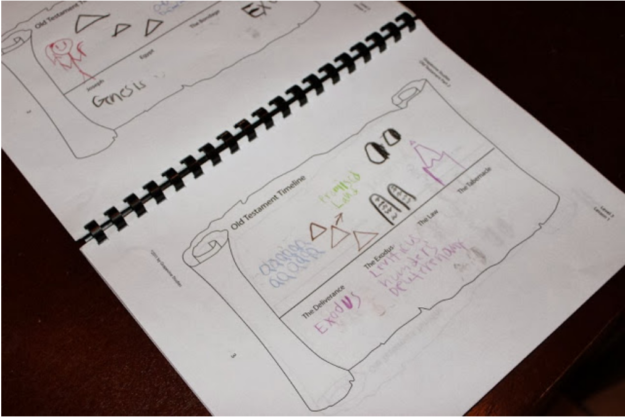
I just love how the timeline overview sets the stage and places everything in context, especially for the big-picture thinkers!
Subsequent lessons include a timeline and memory verse review from past lessons and a storyboard (two lesson pages of drawings) for a portion of scripture followed by some discussion questions.
Levi, our six year old, still prefers to use the traceable version of these books:
while Stephen (age 11) and David (age 9) use other non-traceable versions:
At the end of each lesson, there’s a “my favorite part” student drawing page with memory verse copywork/recitation.
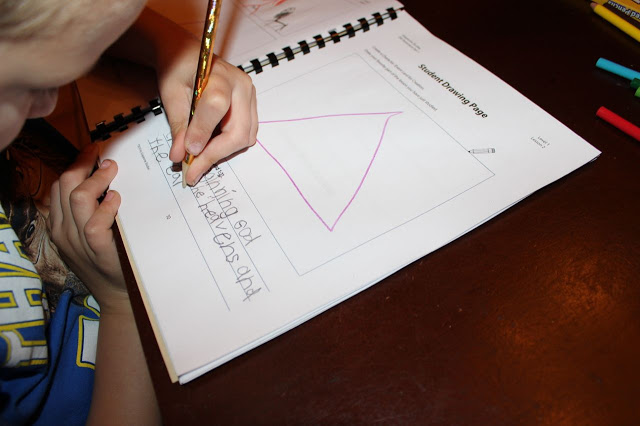
In addition to the above, Elementary Level books also include map activities.
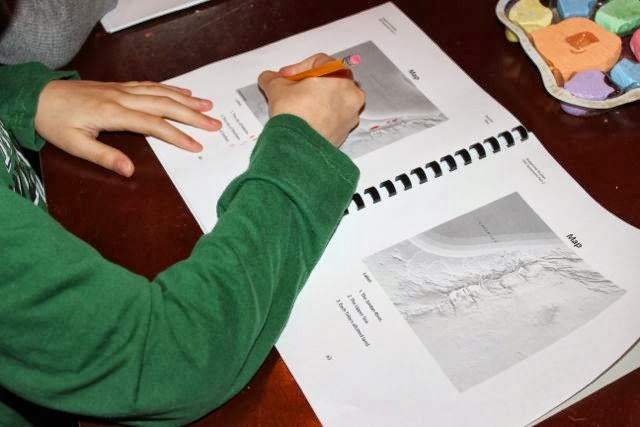
The detailed Teacher’s Guide gives the scriptures to read aloud, a discussion prompt, and a description of what the students are to draw for each scripture passage, along with an example of one way the student can draw it. [The example in the Teacher’s Guide is what I draw on the board, but one of my children prefers to draw his own interpretation.]
Each day we spend about 20 minutes reading, drawing, and discussing the scriptures, so each lesson (Review, Storyboard, & “My Favorite Part”) takes our family about 2 to 3 days to complete.
You can download the sample lessons for each level of this study by visiting each level’s product page here and clicking on “Sample Lesson,” OR you can download all of the levels for this study on the Sample Lessons page. (The image below includes an older version of the cover, but the general layout is the same for the newer editions of these studies.)
Our Ten Favorite Things about Grapevine Studies
- We’re practicing our elements of shape as we learn to express Biblical truths and historical events with drawing.
- The teacher manual is very easy to use and even shows me how to make the stick figures. (Hey, at least we’re practicing OiLs.) It requires very little preparation on my part.
- It has opened up deeper discussion of the scriptures at times when simply reading through the Bible together has not. For example, we have learned about the cycle of apostasy and the set-up of the tabernacle. We’ve discussed things I never really talked about with my children until we used Grapevine Studies.
- At the conclusion of the first (Creation to Jacob) study, our children were able to draw the first part of the Old Testament timeline independently and recite over ten memory verses and important facts from the Bible (with similar results for the other studies). And I love that we are able to connect our Bible study to our memorized timeline! Not only that, these studies include topics often overlooked in Sunday School (such as the Judges and the set up of the Temple), and they have helped us to understand the non-chronological organization of the Books of the Bible.
- It’s organized chronologically and incorporates scripture memorization. Plus, we are remembering more than if we just read the passage together as a family.
- Young children are able to participate because they have a traceable version!
- For Elementary Level books, as we work through the lessons, we periodically flip to the back to label maps that correlates to what we’re studying. Stephen, our personal family geographer, absolutely loves this feature!
- Though you can purchase e-books for a specific age group, there are also multi-level books available for some of the titles. And multi-level is great for a one-room schoolhouse like ours!
- This study uses a classical approach for learning the Bible: repetition and review (grammar), discussion of the material (dialectic), and the student’s picture (rhetoric). (Our children, however, are mainly sticking to the grammar and dialectic stage right now as they draw whatever I draw on the board…) Starting with Middle School level, students learn to use Bible tools such as a topical Bible reference, a concordance, and a Bible dictionary.
- Our finished products are special keepsakes of their personal work. And it’s not just questions and answers in a workbook – it’s (to a certain degree) their interpretation of the scriptures and what actually happened. And that also makes it easy to identify and clear up any misconceptions they might have!

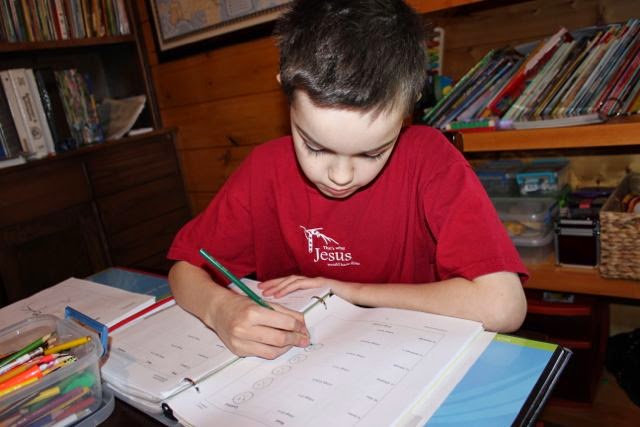
What’s the difference between the Grapevine Studies Levels?
The Beginners program focuses on the main accounts of the Bible. Beginner books have two drawing spaces per page.
Freebies for our readers
One of the things I love about the creation account is the parallel between Days 1, 2 and 3 and Days 4, 5, and 6. I made and printed another page for the boys to review this particular part of the study because it’s just so fascinating to me.
[table]
Days 1-3,Days 4-6
Day 1: Light,Day 4: Sun/Moon/Stars
Day 2: Sky/Sea,Day 5: Creatures of the sky/sea
Day 3: Land & Plants,Day 6: Creatures of the land & man
[/table]
This is a simple sheet, but just in case anyone would like to have a copy, you can download it here.
- Learn the “Books of the Bible” song from Readeez! {A FAMILY FAVORITE!!}
- For a list of free Bible study resources, visit our post on Bible Resources and Character Study.
I received this product free for the purpose of reviewing it. I received no other compensation for this review. The opinions expressed herein are my personal, honest opinions, though your experience may vary. Please read our full disclosure policy for details.

